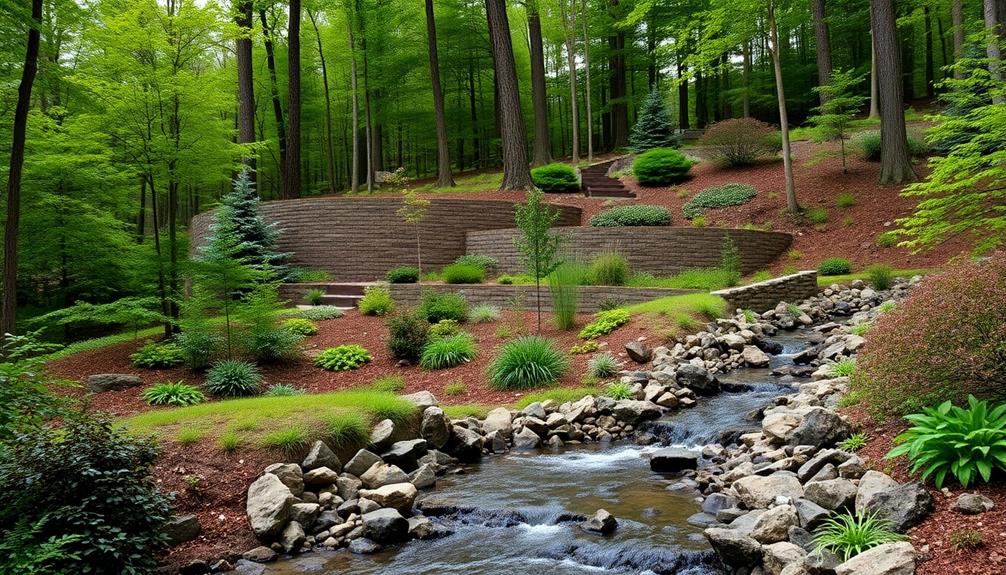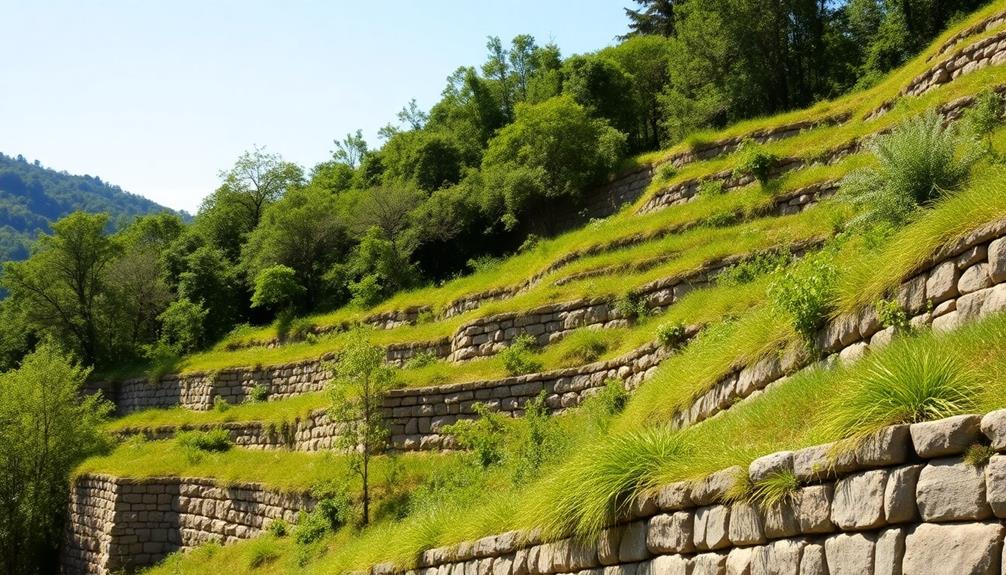In retaining wall construction, the environmental impact holds significant importance as it intertwines with ecological preservation and sustainability principles. Utilizing eco-friendly materials reduces emissions and supports natural ecosystem integration, while minimizing construction waste aligns with community environmental goals. Biodiversity is enhanced by incorporating natural habitats and maintaining ecological corridors, promoting local flora and fauna. Sustainable practices not only prevent soil erosion through vegetation-based stabilization and sustainable drainage solutions but also guarantee long-term structural integrity and community alignment with green initiatives. Understanding these components reveals the multifaceted benefits that underscore the need for environmentally conscious construction methods.
Table of Contents
ToggleWalls Contractor Highlights
- Utilizing eco-friendly materials reduces emissions and integrates structures with natural surroundings, supporting sustainability efforts.
- Preservation of biodiversity and habitats enhances local ecosystems and fosters community pride in environmental stewardship.
- Efficient construction planning minimizes waste, supporting recycling initiatives and reducing the environmental footprint.
- Sustainable drainage solutions prevent erosion, maintain structural integrity, and safeguard the environment through advanced engineering techniques.
- Using local materials decreases transportation emissions and aligns with community-wide environmental awareness and sustainability goals.
Defining Environmental Impact

In retaining wall construction, defining environmental impact requires a thorough examination of the industry's adoption of eco-friendly materials, which play an essential role in mitigating adverse effects on the ecosystem. For example, methods such as limestone wall installation provide both aesthetic appeal and erosion prevention without harming local wildlife habitats.
The preservation of biodiversity and habitats is paramount, emphasizing the importance of selecting construction practices that minimize disturbance to existing flora and fauna. Additionally, implementing strategies to guarantee resource efficiency and reduce the project's overall ecological footprint ensures alignment with sustainable development goals.
Significance of Eco-Friendly Materials
Sustainably selecting materials often plays a pivotal role in minimizing the environmental impact of retaining wall construction. Eco-friendly materials are essential not only for reducing emissions but also for creating structures that blend seamlessly with their natural surroundings, enhancing the sense of belonging to both the community and environment.
By choosing materials that are sustainably sourced and have a reduced carbon footprint, construction projects can drastically mitigate their ecological impact.
Reduced Carbon Footprint: Environmentally conscious materials typically require less energy to produce and transport, resulting in fewer greenhouse gas emissions.
Resource Efficiency: These materials promote the use of recycled and renewable resources, decreasing the dependency on finite resources and encouraging sustainability.
Longevity and Durability: Eco-friendly materials are often engineered to withstand harsh environmental conditions, leading to longer life spans and reduced need for replacement, offering substantial lifecycle cost benefits.
Aesthetic Integration: Such materials can be designed to complement natural landscapes, fostering community pride and commitment to preserving the environment's intrinsic beauty.
Utilizing eco-friendly materials not only supports sustainable development but also strengthens communal ties through responsible environmental stewardship.
Biodiversity and Habitat Preservation
The selection of eco-friendly materials in retaining wall construction extends beyond minimizing emissions to encompass broader ecological benefits, particularly biodiversity and habitat preservation. The integration of sustainable materials guarantees that the immediate environment is not only preserved but enhanced, providing a rich, nurturing habitat for local flora and fauna. Employing bioengineered solutions, such as vegetated retaining walls or living walls, for instance, supports plant growth and creates microhabitats, which subsequently bolster local biodiversity.
Key to this approach is understanding the intricate networks within ecosystems, whereby each plant or animal species serves to maintain balance. By prioritizing materials that blend naturally with the surrounding landscape, construction projects can facilitate continuity of habitat, allowing species to thrive. This method further aids in creating ecological corridors—links between habitats that are often fragmented by urban development.
Furthermore, environmentally conscious stakeholders, from project designers to community members, align towards a common purpose: fostering a shared commitment to sustainability. This collective aim not only benefits wildlife but also strengthens community bonds as individuals coalesce in efforts promoting the health of their shared ecosystems. Consequently, retaining wall construction contributes substantially to preserving biodiversity, bridging the gap between urban innovation and natural preservation.
Minimizing Construction Waste
Construction's environmental impact is profoundly defined by the amount of waste generated throughout the process, making waste minimization an essential aspect of sustainable practices. By focusing on reducing construction waste, we not only lessen the environmental footprint of retaining wall projects but also foster community-conscious development that aligns with collective environmental goals. Understanding the importance of minimizing waste involves the integration of efficient strategies that promote reuse and recycling, contributing to a cyclical economy that benefits everyone.
Effective waste minimization requires disciplined planning and execution. Here are four pivotal strategies to contemplate:
- Material Selection: Choose materials that are durable and recyclable. Opt for suppliers that prioritize sustainability, providing transparency about the life cycle of their products.
- Accurate Project Planning: Precisely plan material quantities to avoid over-ordering. Use digital estimations and workflows to guarantee that only what's necessary is procured, reducing surplus and financial waste.
- Reuse and Recycling: Implement on-site recycling stations and partner with local recycling facilities. This commitment to recycling turns potential waste into valuable resources.
- Modular Design: Utilize design principles that support deconstruction and reuse. Modular components allow for the easy disassembly and repurposing of materials for future projects.
Through these strategies, construction can achieve significant progress toward sustainability and community alignment.
Benefits

Incorporating eco-friendly materials in retaining wall construction drastically diminishes the carbon footprint associated with traditional building practices, marking a transformative shift towards sustainability. Companies like Boulder Walls, established over 20 years ago, have recognized the importance of providing high-quality and long-lasting materials such as limestone, boulders, and granite that are not only durable but environmentally considerate.
This approach not only supports biodiversity conservation by integrating natural habitats into construction designs but also aligns with overarching sustainable development strategies that prioritize environmental health. By championing these green methodologies, the construction industry can lead a broader movement towards ecological responsibility and long-term environmental stewardship.
Promotes Eco-Friendly Materials
Utilizing eco-friendly materials in retaining wall construction promotes sustainability and environmental responsibility. This approach connects individuals with a shared goal of safeguarding natural resources and aligning construction practices with environmental stewardship. By integrating green alternatives, builders and communities commit to a future where development harmonizes with ecological preservation. The application of eco-friendly materials not only meets structural and aesthetic demands but also addresses the broader environmental concerns that resonate with a conscientious audience.
Durability and Resilience: Eco-friendly materials often boast enhanced durability, ensuring the longevity of retaining structures and reducing the frequency of replacement, thereby conserving resources and minimizing environmental disturbance.
Biodegradability: Many sustainable materials decompose naturally without leaving behind harmful residues, supporting waste management efforts and maintaining natural equilibrium in surrounding landscapes.
Recycling and Reusability: Eco-materials encourage recycling post usage, contributing to circular economies that promote material recovery and reuse, thus reducing landfill burden.
Aesthetic Integration with Nature: These materials often blend seamlessly with natural surroundings, offering aesthetically pleasing solutions that enhance community cohesiveness while respecting local ecosystems.
Reduces Carbon Footprint Significantly
The reduction of carbon footprint in retaining wall construction presents a substantial benefit of adopting eco-friendly practices. Modern construction techniques integrate sustainable materials such as recycled concrete or timber, which significantly decreases the carbon emissions associated with traditional methods. Using local materials further reduces transportation emissions, minimizing the ecological impact. Additionally, employing advanced design software aids in optimizing resource usage, ensuring the construction of retaining walls with precision that leads to less waste and reduced need for energy-intensive remediation.
These improvements resonate with a community's growing environmental awareness and collective responsibility towards a sustainable future. Remarkably, the construction industry's shift towards cleaner operations aligns with wider climate goals, thereby reinforcing shared values among community members who seek participation in environmentally conscious endeavors. Embracing such practices not only contributes to direct reductions in carbon emissions but also fosters a sense of community ownership and pride in local projects that embody sustainability.
Moreover, eco-friendly retaining walls often qualify for green certifications, enhancing property value while yielding long-term cost savings through reduced energy consumption. By choosing sustainable retaining wall solutions, individuals become integral participants in advancing global initiatives aimed at mitigating climate change, affirming their role within a community committed to ecological stewardship.
Enhances Biodiversity Conservation Efforts
Adopting eco-friendly retaining wall construction techniques empowers biodiversity conservation efforts, serving as a critical strategy in mitigating habitat disruption. Integrating nature-friendly materials and construction methodologies fosters habitats that support diverse species, connecting communities with the natural world and promoting harmonious coexistence. This approach not only safeguards ecosystems but also enhances local biodiversity, creating thriving environments that align with community values. Professionals in the field can leverage sustainable options to construct retaining walls that double as ecological sanctuaries.
When constructing retaining walls with a focus on biodiversity, several key strategies guarantee substantial benefits:
- Utilization of Natural Materials: Choosing stone, timber, and other organic materials helps create habitats that blend seamlessly with native landscapes, supporting local flora and fauna.
- Design for Natural Water Flow: Incorporating features that maintain natural water pathways prevents habitat fragmentation and fosters aquatic ecosystems.
- Vegetative Integration: Planting greenery along retaining walls supports pollinators and other wildlife, fostering symbiotic relationships within the ecosystem.
- Habitat Features: Including niches, ledges, and burrows in construction allows small animals and insects to find refuge and thrive.
Aligning with these strategies not only conserves biodiversity but also fortifies communities' connection to natural surroundings, fostering a shared commitment to preserving the earth's ecosystem integrity.
Supports Sustainable Development Practices
Constructing retaining walls with sustainability at the forefront epitomizes a commitment to enduring development that balances environmental, economic, and social objectives. By adopting sustainable practices in retaining wall construction, communities can incorporate methods and materials that minimize ecological disruption while ensuring the project's viability and longevity. Such approaches include the use of recycled or locally sourced materials, reducing carbon footprints, and promoting the integration of green spaces or vegetative coverings that align with the natural landscape.
These practices not only support environmental health but also enhance the social and economic well-being of communities by creating robust structures that require less maintenance and adapt to climate variations.
In addition, sustainable development practices in retaining wall construction offer economic advantages through potential cost savings over the long term. Builders and planners can leverage advancements in technology and environmentally friendly techniques to construct walls that not only fulfill regulatory requirements but also build community resilience. These construction practices demonstrate that economic and social progress does not need to come at the expense of the environment. By fostering a culture of sustainability, communities empower themselves to contribute positively to broader efforts aimed at securing the planet's health and prosperity for future generations.
Soil Erosion Prevention Measures

When addressing soil erosion in retaining wall construction, it is essential to examine techniques that harmonize with the environment while effectively maintaining structural integrity. Integrating vegetation-based stabilization techniques, sustainable drainage solutions, and innovative erosion control materials not only curbs soil displacement but also enhances the ecological value of the site. Below is a table illustrating the primary components involved in these soil erosion prevention measures:
| Technique | Description |
|---|---|
| Vegetation-Based Stabilization | Utilizes plant roots to reinforce soil stability |
| Sustainable Drainage Solutions | Manages water flow to minimize erosion risks |
| Erosion Control Materials | Implements geotextiles and matting to secure soil |
Vegetation-Based Stabilization Techniques
In recent years, the integration of vegetation-based stabilization techniques has gained prominence as an effective and sustainable approach to preventing soil erosion in retaining wall construction. This method utilizes natural vegetation to strengthen soil structure, ensuring the long-term stability of walls while promoting ecological harmony. As communities increasingly prioritize environmental stewardship, these techniques provide an opportunity to blend human engineering with nature's resilience.
Vegetation not only helps anchor soil but also facilitates water absorption, reducing surface runoff and enhancing the wall's durability.
The key benefits of vegetation-based stabilization include:
- Biodiversity Enhancement: Introducing native plant species fosters a habitat for local wildlife and enhances biodiversity, thus creating a supportive ecosystem that contributes to the overall health of the environment.
- Aesthetic Appeal: Greenery adds visual appeal to retaining walls, transforming otherwise stark structures into vibrant landscapes that resonate with the community's desire for natural beauty.
- Cost-Effectiveness: While initial installation costs can be higher, maintenance expenses are often lower, as vegetation helps naturally manage erosion without the need for extensive interventions.
- Climate Resilience: The increase in vegetation can buffer extreme weather impacts by mitigating erosion caused by heavy rainfall and stabilizing soil during droughts.
This symbiotic relationship between construction and nature underscores a commitment to sustainable development and aligns with collective aspirations for a harmonious existence.
Sustainable Drainage Solutions
Addressing soil erosion effectively requires the implementation of sustainable drainage solutions, a crucial component in retaining wall construction. These solutions encompass strategic planning and engineering techniques that mitigate the adverse effects of water flow and soil displacement, safeguarding both the environment and structural integrity.
Central to maintaining stability and longevity, sustainable drainage systems are designed with a nuanced understanding of hydrological processes and soil dynamics, ensuring that water is directed away from vulnerable areas, consequently preventing erosion before it begins.
Incorporating permeable materials and bioengineered designs, sustainable drainage solutions harmonize with the natural environment, reducing ecological disruption. These measures include carefully calibrated grading, swales, and infiltration basins, integrating the landscape's natural features to enhance water absorption and dispersion. This not only aids in erosion control but also contributes to groundwater recharge and habitat preservation, aligning with broader sustainability objectives.
Erosion Control Materials
Selecting appropriate erosion control materials is imperative in preventing soil erosion in retaining wall construction. As communities increasingly recognize the importance of maintaining land integrity, the call for sustainable practices becomes ever more crucial. Erosion control is critical not just for the longevity of retaining walls but also for preserving the surrounding environment.
Careful selection and application of materials can greatly mitigate erosion risks, ensuring both stability and ecological harmony. These materials act as a pivotal line of defense against the deleterious effects of wind, water, and gravity on vulnerable soil.
Consider the following essential erosion control materials commonly used in retaining wall projects:
- Geotextiles: These permeable fabrics are placed on soil surfaces to enhance stability and limit erosion, allowing water to pass while retaining soil particles.
- Erosion control blankets (ECBs): Crafted from natural fibers, ECBs provide immediate surface protection by stabilizing the topsoil, supporting the germination of vegetation.
- Vegetative cover: Employing grass, shrubs, or trees offers a natural approach, utilizing root systems to secure soil and reduce surface runoff.
- Riprap: The strategic placement of rock or stone serves as a durable barrier, diffusing the energy of flowing water and protecting soil from erosion.
Incorporating these elements fosters environmental stewardship and aligns construction practices with community values.
Walls Contractor FAQ
How Do Construction Materials Affect the Carbon Footprint of Retaining Walls?
Construction materials profoundly influence a retaining wall's carbon footprint, with concrete and steel contributing higher emissions compared to sustainable options like recycled materials or timber. Selecting eco-friendly materials fosters community responsibility and sustainability in construction practices.
What Are the Long-Term Environmental Effects of Improperly Constructed Retaining Walls?
Improperly constructed retaining walls can lead to soil erosion, habitat disruption, and increased sedimentation in aquatic systems. Such consequences undermine community ecosystems, compromise local biodiversity, and jeopardize the shared natural resources essential to communal environmental health and prosperity.
Can Retaining Walls Support Biodiversity and Local Ecosystems?
Retaining walls can indeed support biodiversity and bolster local ecosystems. By incorporating native vegetation and ecologically sensitive designs, they can provide habitats, promote soil health, enhance water management, and integrate harmoniously into the surrounding natural landscape.
How Does Climate Change Influence the Design of Retaining Walls?
Climate change necessitates adapting retaining wall designs to accommodate increased rainfall, rising temperatures, and extreme weather events. Incorporating resilient materials and sustainable practices can guarantee walls support both structural integrity and environmental harmony, fostering a sense of community security.
What Are the Regulatory Policies for Environmental Compliance in Retaining Wall Projects?
Regulatory policies for environmental compliance in retaining wall projects typically involve adherence to federal, state, and local guidelines. These may include assessments on erosion control, habitat preservation, and water quality standards, ensuring sustainable and environmentally responsible construction practices.







